City Hall Exterior Frieze Panels
Introduction
Text-to-speech Audio
A stone tapestry featuring rich symbolism wraps the exterior of the 6th floor of City Hall. Each face of City Hall shows a series of carvings made directly into the Indiana limestone façade that stand 9 feet 6 inches tall and have a depth of 5 inches. There is a specific historical motif for each face with a prominent central panel and multiple supporting panels. The intricate symbolism of each panel was planned from April to August of 1936 and is the result of a combined effort of three artists. The panels represent the historical development of the modern City of Kansas City, Missouri.
Images
South Frieze Panel - KC Star Commentary
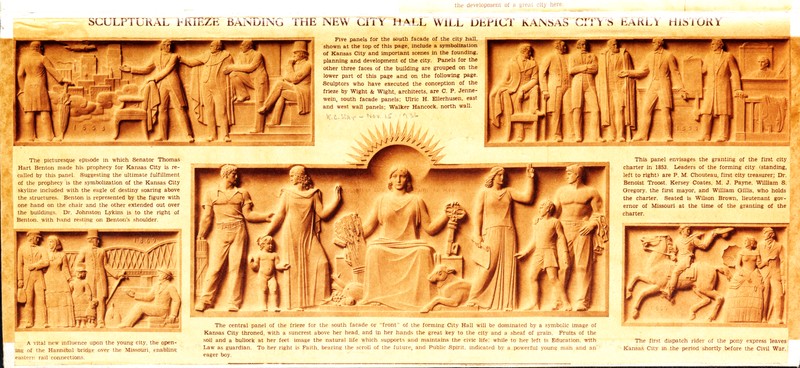
North Frieze Panel - KC Star Commentary
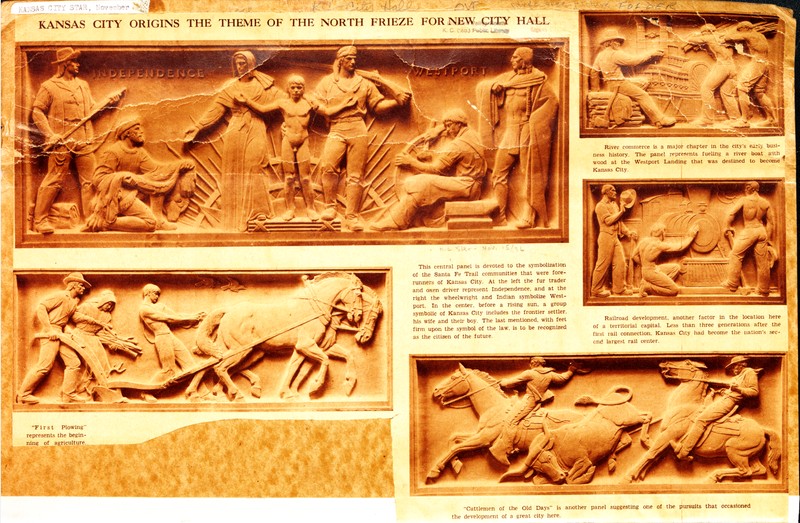
East Frieze Panel - KC Star Commentary
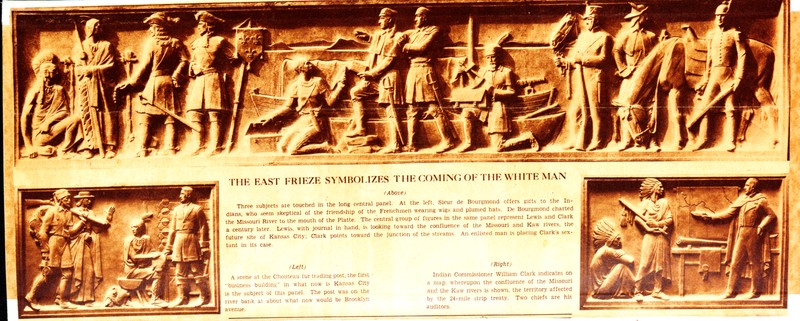
West Frieze Panel - KC Star Commentary
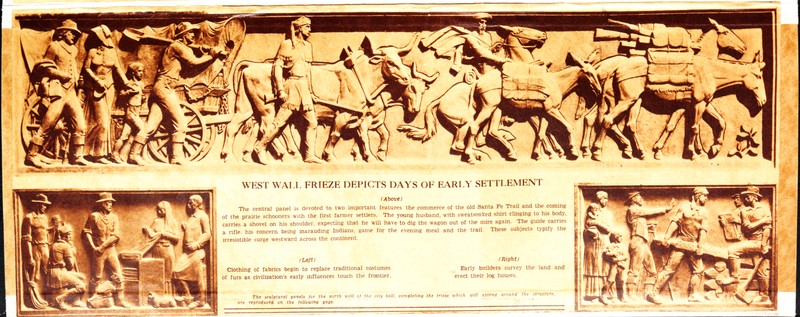
Frieze Panel Details
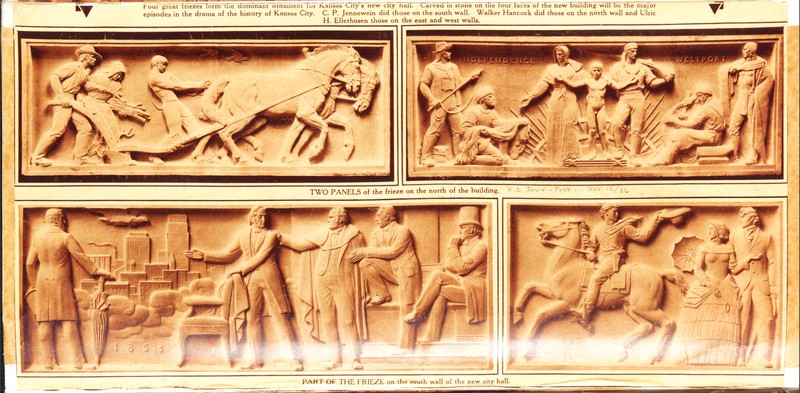
Frieze Panel Details
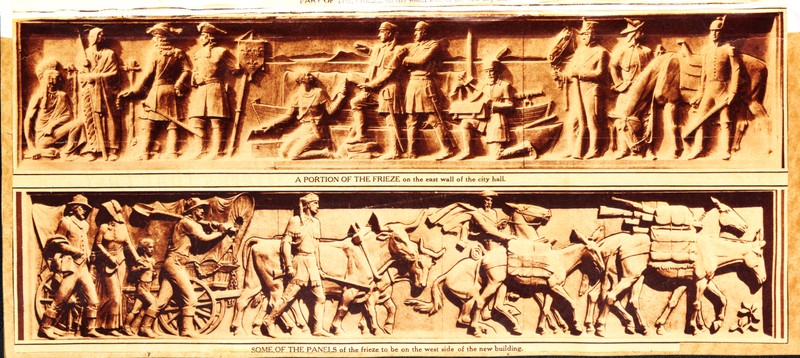
Story of a City in Stone
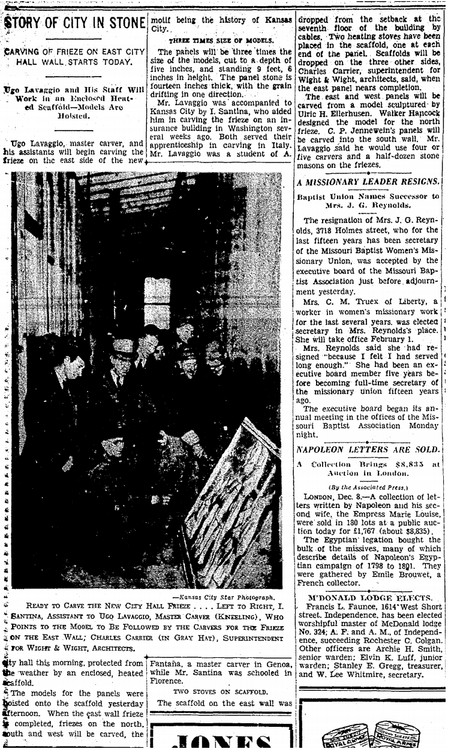
Backstory and Context
Text-to-speech Audio
It is important to understand that the symbolism depicted in these friezes represents a particular and arbitrarily narrow scope and interpretation of the history of Kansas City, Missouri. While some panels feature figures of Indigenous Peoples and Native Americans, the sculptural silence on the ancestral history of the Indigenous Peoples that inhabited this territory is deafening to the contemporary ear. Additionally, the characterization of the symbolism featured in the accompanying images of historic Kansas City Star articles may be uncomfortable for some to view. Unfortunately, it is beyond the scope of this entry to provide – or do justice to – the history of the Indigenous Peoples who occupied this territory long before the Spanish, French, or U.S. claimed to own this land, and who were forcibly dispossessed of their territory through the forces of colonization, disease, government treaty, and forced assimilation. However, links are provided below to numerous resources, please explore them to learn more.
All of the carving work was done by a master stone carver, Ugo Lavaggio of New York, and his assistants. The carvings are located at the sixth-floor level, just before the seventh-floor setback where the building begins its vertical ascent. While the carvings are large enough to be viewed from the ground, this entry will provide explanations of the symbolism and several photographs of the detail.
The South Face:
The panels on the South face of City Hall were designed by C. P. Jennewein. These panels are meant to represent the political and social foundations of the City of Kansas City, Missouri. The central panel features an enthroned female embodiment of Kansas City. She is holding a sheaf of grain and the key to the City and agricultural products rest at her feet symbolizing the bountiful produce of the area.
Adjacent South panels display other notable moments in the early history of Kansas City, such as Senator Thomas Hart Benton’s prophecy about the City’s future, the construction of the Hannibal Bridge – the first railroad bridge to span the Missouri River in 1868-1869 – and the departure of a Pony Express rider shortly before the Civil War. There is also a panel depicting the granting of the original charter for the City of Kansas in 1852. This panel features notable members of the charter party, including a descendant of Francois Choteau and Dr. Benoist Troost (Staff, The Kansas City Star). Dr. Troost has the infamous legacy of being an owner of enslaved persons, and his name continues to adorn a street regarded as a historic racial and economic line of segregation still present in the makeup of Kansas City, Missouri today.
The North Face:
The panels on the North face were designed by Walker Hancock to represent the industrial development of the City. The central motif is symbolic of the Santa Fe Trail communities, featuring an oxen driver and fur trader on the left to symbolize Independence, Missouri, and a wheelwright and Indigenous Person on the right to symbolize Westport. In the center stands a family symbolic of Kansas City; two frontier settlers with their child, all standing on a fasces symbolic of the foundation of law. The surrounding panels depict a field being plowed, cattle being herded, a riverboat fueling up at Westport Landing, and the development of the railroad.
The East and West Faces:
The East and West panels were designed by Ulric H. Ellerhusen. These panels are meant to be symbolic of “Early Settlement” and “The Coming of the White Man,” giving them the unfortunate distinction of containing the majority of unsavory imagery and interpretation. At the time these friezes were designed, the concept of “Manifest Destiny” was largely unchallenged and the predominant narrative of “Westward Expansion” was one of heroism and triumph over Nature. From a contemporary standpoint, it may be a more apt interpretation to read this imagery in terms of the colonial displacement of Indigenous Peoples, mass migrations of European immigrants displaced for any number of social, cultural, and religious reasons, and the orientation of early industrial capitalism and a burgeoning U.S. government toward expansion.
Sources
Staff, The Kansas City Star. Sculptural Frieze Banding City Hall Will Depict Kansas City’s Early History, Kansas City Star (Published as The Kansas City Star), November 15, 1936, P46. 15 Nov. 1936, https://infoweb-newsbank-com.mcpl.idm.oclc.org/apps/news/document-view?p=WORLDNEWS&docref=image/v2%3A1126152C152E4978%40EANX-NB-15F1D472E104F5BD%402428488-15F1D116A8651691%4045.
Staff, The Kansas City Times. Story of City in Stone, Kansas City Times (Published as The Kansas City Times), December 9, 1936, P6. 9 Dec. 1936, https://infoweb-newsbank-com.mcpl.idm.oclc.org/apps/news/document-view?p=WORLDNEWS&t=favorite%3A1126152C%21Kansas%20City%20Star%20Collection%20including%20Historical%20archives/decade%3A1930%211930%2B-%2B1939/year%3A1936%211936&sort=YMD_date%3AD&fld-base-0=alltext&maxresults=20&val-base-0=%22frieze%22%20and%20%22city%20hall%22%20and%201936&docref=image/v2%3A11FF2A92A519802A%40EANX-NB-16B5D8F113C20E0F%402428512-16B44052ADC79D37%405-16B44052ADC79D37%40.
Stephanson, Anders. Manifest Destiny: American Expansion and the Empire of Right. Farrar, Straus and Giroux, 1996.
The Kansas City Star
The Kansas City Star
The Kansas City Star
The Kansas City Star
The Kansas City Star
The Kansas City Stary
The Kansas City Times
